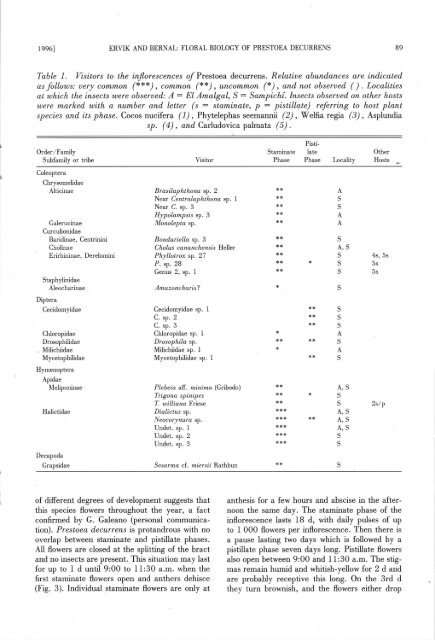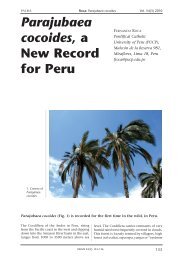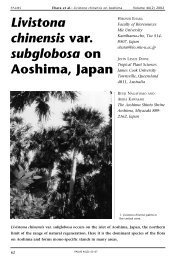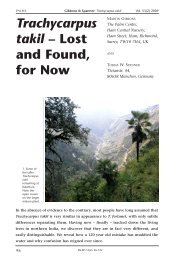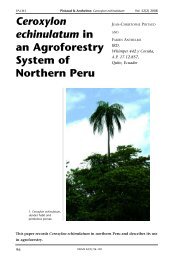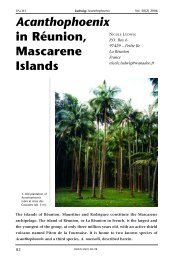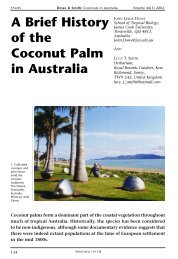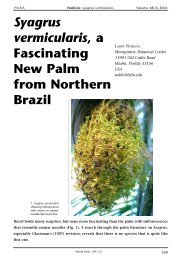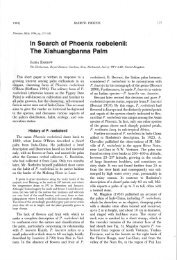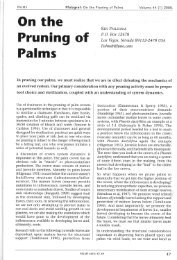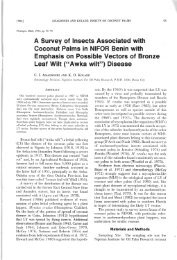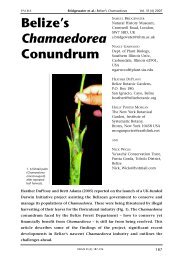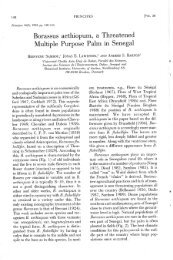Monoecious Palm Prestoea decurrens on - International Palm Society
Monoecious Palm Prestoea decurrens on - International Palm Society
Monoecious Palm Prestoea decurrens on - International Palm Society
You also want an ePaper? Increase the reach of your titles
YUMPU automatically turns print PDFs into web optimized ePapers that Google loves.
9961<br />
ERVIK AND BERNAL: FLORAL BIOLOCY OF PRESTOEA DECURRENS<br />
B9<br />
Table 1. Visitors to the inf.orescences olf<str<strong>on</strong>g>Prestoea</str<strong>on</strong>g> <str<strong>on</strong>g>decurrens</str<strong>on</strong>g>. Relatiae abundances are indicated<br />
as follows: aery comm<strong>on</strong> (***), c<strong>on</strong>'nrl<strong>on</strong> (**), ur"o*rn<strong>on</strong> (*), and not obseraed ( ). Localities<br />
at which the insects were obserued: A: El Amalgal, S : Sampichl. Insects obseraed <strong>on</strong> other hosts<br />
were marked with a nurnber and letter (s : staminate, p : pistillate) referring to host plant<br />
species and its phase. Cocos nucifera (1), Phytelephas seemannii (2) , WeIfra regia (3), Asplundia<br />
sp. (4) , and Carludovica palmata (5) .<br />
Order,/Family<br />
Subfamily or tribe<br />
Staminate<br />
Phase<br />
Pisti.<br />
late<br />
Other<br />
Phase Locality Hosts *<br />
Coleoptera<br />
Chrysomelidae<br />
Alticinae<br />
Galerucinae<br />
Curculi<strong>on</strong>idae<br />
Baridinae, Centrinini<br />
Cholinae<br />
Erirhininae, Derelomini<br />
Staphylinidae<br />
Aleocharinae<br />
Brasilaphth<strong>on</strong>a sp. 2<br />
Near Centralaphth<strong>on</strong>a sp. I<br />
Near C. sp. 3<br />
Hypolampsis sp. 3<br />
M<strong>on</strong>olepta sp.<br />
B<strong>on</strong>dariella sp. 3<br />
Cholus cananchensis Heller<br />
Phyllotrox sp. 27<br />
P. sp. 28<br />
Genus 2, sp. I<br />
Amaz<strong>on</strong>charis?<br />
A<br />
S<br />
S<br />
A<br />
A<br />
S<br />
A,S<br />
S<br />
* s<br />
S<br />
4s, 5s<br />
5s<br />
5s<br />
Diptera<br />
Cecidomyidae<br />
Chloropidae<br />
Drosophilidae<br />
- Milichiidae<br />
Mycetophilidae<br />
Cecidomldae sp. I<br />
C. sp. 2<br />
C. sp. 3<br />
Chloropidae sp. I<br />
Drosophila sp.<br />
Milichiidae sp. I<br />
Mycetophilidae sp. I<br />
S<br />
s<br />
S<br />
A<br />
S<br />
A<br />
S<br />
Hymenoptera<br />
Apidae<br />
Melip<strong>on</strong>inae<br />
Halictidae<br />
Plebeia aff. minima (Gribodo)<br />
Trig<strong>on</strong>a spinipes<br />
T. uilliana Friese<br />
Dialictus sp.<br />
Neocorynura sp.<br />
Undet. sp. I<br />
Undet. sp. 2<br />
Undet. sp. 3<br />
A,S<br />
S<br />
S<br />
A,S<br />
A,S<br />
A,S<br />
S<br />
S<br />
2s/p<br />
Dempoda<br />
Grapsidae<br />
Sesarma cf. miersii Rathbun<br />
S<br />
of different degrees of development suggests that<br />
this species flowers throughout the year, a fact<br />
c<strong>on</strong>firmed by G. Galeano (pers<strong>on</strong>al communicati<strong>on</strong>).<br />
<str<strong>on</strong>g>Prestoea</str<strong>on</strong>g> <str<strong>on</strong>g>decurrens</str<strong>on</strong>g> is protandrous with no<br />
overlap between staminate and pistillate phases.<br />
All flowers are closed at the splitting of the bract<br />
and no insects are present. This situati<strong>on</strong> may last<br />
for up to I d until 9:00 to ll:30 a.m. when the<br />
first staminate flowers open and anthers dehisce<br />
(Fig. 3). Individual staminate flowers are <strong>on</strong>ly at<br />
anthesis for a few hours and abscise in the afterno<strong>on</strong><br />
the same day. The staminate phase of the<br />
inflorescence lasts 18 d, with daily pulses of up<br />
to I 000 flowers per inflorescence. Then there is<br />
a pause lasting two days which is followed by a<br />
pistillate phase seven days l<strong>on</strong>g. Pistillate flowers<br />
also open between 9:00 and I l:30 a.m. The stigmas<br />
remain humid and whitish-yellow for 2 d and<br />
are probably receptive this l<strong>on</strong>g. On the 3rd d<br />
they turn brownish, and the flowers either drop


